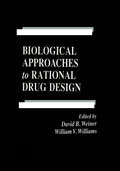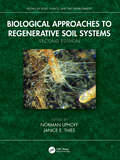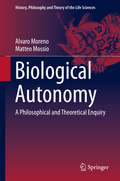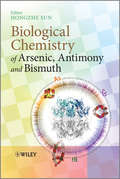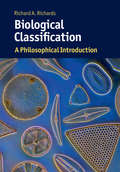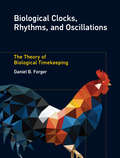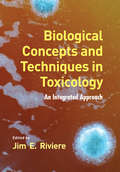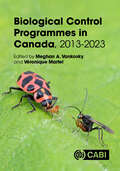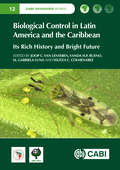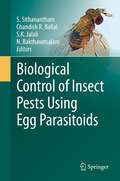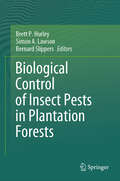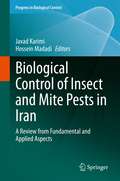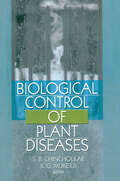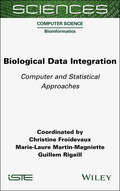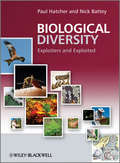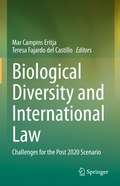- Table View
- List View
Biological Approaches to Rational Drug Design
by David B. Weiner William V. WilliamsThis book exploits an understanding of disease pathogenesis by applying a variety of biological agents to therapy. It provides a broad overview of the current methodologies being applied to biological approaches to rational drug design and in depth analyses of progress in this specific field.
Biological Approaches to Regenerative Soil Systems (Books in Soils, Plants, and the Environment)
by David Montgomery Stephen Wood Jules Pretty Norman Uphoff Andrew S. Ball Olivier Husson Mark Laing Radha Prasanna Janice E. Thies Febri Doni Odo PrimavesiAgriculture in the 21st century will need considerable modification to remain both productive and sustainable. Greater production is needed to meet the needs of our still-growing populations and to combat hunger and poverty. Declines in soil health and the pollution of water sources are making many of our production systems less tenable. These adverse trends are exacerbated more and more by the impacts of climate change. There are, fortunately, alternative methods available for agricultural practice that can countervail these constraints. Biological Approaches to Regenerative Soil Systems brings together the work of both researchers and practitioners to map out better approaches to contemporary agriculture that draw upon both old and new knowledge. It presents the science that underlies more biologically driven strategies as well as contemporary innovative experiences in diverse parts of the world. Both accepted research and these varied experiences encourage confidence that these approaches, not relying primarily on the introduction of new varieties and on exogenous inputs, can succeed. This book updates and revises a preceding volume Biological Approaches to Sustainable Soil Systems published by CRC Press in 2006. So much has been learned and done on this subject in the past decade and a half that a second edition was warranted. For instance, the first edition was published, knowledge about plant-soil microbiomes, which are a frequent focus in this book, has mushroomed. Because sustainability is a broad term and an end-state, the editors preferred to assemble expertise regarding regenerative agriculture, which is concerned with the means for achieving sustainability. The concept of regenerative soil systems, entities that are more complex and multifaceted than "soil" alone, also incorporates a concern with having more resilient agricultural systems, ones that are better able to cope with the multiple stresses of climate change that are foreseen for the decades ahead. The book’s chapters representing a wide range of disciplines were contributed by 84 scientists and practitioners from 20 countries. Although they come from persons with in-depth knowledge of their respective fields, the chapters are written to be accessible to readers who are not trained in the specialized subjects. Taken together, the chapters provide students, researchers, practitioners, planners, and policy makers with a comprehensive understanding of both the science and the steps needed to regenerate and sustain soil systems around the world for the long-term benefit of humankind and the environment.
Biological Autonomy: A Philosophical and Theoretical Enquiry (History, Philosophy and Theory of the Life Sciences #12)
by Alvaro Moreno Matteo MossioSince Darwin, Biology has been framed on the idea of evolution by natural selection, which has profoundly influenced the scientific and philosophical comprehension of biological phenomena and of our place in Nature. This book argues that contemporary biology should progress towards and revolve around an even more fundamental idea, that of autonomy. Biological autonomy describes living organisms as organised systems, which are able to self-produce and self-maintain as integrated entities, to establish their own goals and norms, and to promote the conditions of their existence through their interactions with the environment. Topics covered in this book include organisation and biological emergence, organisms, agency, levels of autonomy, cognition, and a look at the historical dimension of autonomy. The current development of scientific investigations on autonomous organisation calls for a theoretical and philosophical analysis. This can contribute to the elaboration of an original understanding of life - including human life - on Earth, opening new perspectives and enabling fecund interactions with other existing theories and approaches. This book takes up the challenge.
Biological Basis and Therapy of Neuroses
by Ashoka PrasadParadoxically, it is the termneurosis more than perhaps any other which has the implication of organic basis. Possibly the popular but erroneous belief that it implies impeded systematic biological research in this area. On scrutiny, it becomes obvious that there is considerable evidence for a biological basis to these hitherto ignored conditions. This book endeavours to present this information in a systematic manner.
Biological Centrifugation
by Dr John GrahamAn important introduction to the use of the centrifuge in the biology laboratory, Biological Centrifugation is also useful for more experienced workers. The book describes the background and the principles behind centrifugation, including sedimentation theory. The book also considers the different types of centrifuge and other centrifuge hardware available, density gradient media and gradient technology. Although aimed primarily at the novice, this title also provides information to allow more experienced workers to modify and update existing techniques.
Biological Chemistry of Arsenic, Antimony and Bismuth
by Hongzhe SunArsenic, antimony and bismuth, three related elements of group 15, are all found in trace quantities in nature and have interesting biological properties and uses. While arsenic is most well known as a poison - and indeed the contamination of groundwater by arsenic is becoming a major health problem in Asia - it also has uses for the treatment of blood cancer and has long been used in traditional chinese medicine. Antimony and bismuth compounds are used in the clinic for the treatment of parasitic and bacterial infections.Biological Chemistry of Arsenic, Antimony and Bismuth is an essential overview of the biological chemistry of these three elements, with contributions from an international panel of experts. Topics covered include:chemistry of As, Sb and Bibiological chemistry of arsenicbiological chemistry of Sb and Biarsenic and antimony speciation in environmental and biological samplesarsenic in traditional chinese medicinearsenic in aquifersbiomethylation of As, Sb and Biuptake of metalloids by cellsbismuth complexes of porphyrins and their potential in medical applicationsHelicobacter pylori and bismuthmetabolism of arsenic trioxide in blood of the acute promyelocytic leukemia patientsanticancer properties of As, Sb and Biradio-Bi in cancer therapygenotoxicity of As, Sb and Bimetallomics as a new technique for As, Sb and Bimetalloproteomics for As, Sb and BiBiological Chemistry of Arsenic, Antimony and Bismuth conveys the essential aspects of the bioinorganic chemistry of these three elements, making this book a valuable complement to more general bioinorganic chemistry texts and more specialized topical reviews. It will find a place on the bookshelves of practitioners, researchers and students working in bioinorganic chemistry and medicinal chemistry.
Biological Classification: A Philosophical Introduction (Cambridge Introductions to Philosophy and Biology)
by Richard A. RichardsModern biological classification is based on the system developed by Linnaeus, and interpreted by Darwin as representing the tree of life.But despite its widespread acceptance, the evolutionary interpretation has some problems and limitations. <P><P> This comprehensive book provides a single resource for understanding all the main philosophical issues and controversies about biological classification. It surveys the history of biological classification from Aristotle to contemporary phylogenetics and shows how modern biological classification has developed and changed over time. Readers will also be able to see how biological classification is in part a consequence of human psychology, language development and culture. <P>The book will be valuable for student readers and others interested in a range of topics in philosophy and biology.<P> Comprehensive, covering all the main philosophical issues in biological classification<P> Includes a survey of the history of biological classification from Aristotle to the present<P> Naturalistic, in the sense that it begins with what the sciences tell us about the cultural, psychological and linguistic foundations of biological classification
Biological Clocks
by Susan BinkleyBiological Clocks introduces the subject of human chronobiology. It describes biological clocks; why we have clocks; how biological clocks relate to sleep disorders, depression, and jet lag; and how the reader can measure his/her own rhythms.
Biological Clocks, Rhythms, and Oscillations: The Theory of Biological Timekeeping (The\mit Press Ser.)
by Daniel B. ForgerAn introduction to the mathematical, computational, and analytical techniques used for modeling biological rhythms, presenting tools from many disciplines and example applications.All areas of biology and medicine contain rhythms, and these behaviors are best understood through mathematical tools and techniques. This book offers a survey of mathematical, computational, and analytical techniques used for modeling biological rhythms, gathering these methods for the first time in one volume. Drawing on material from such disciplines as mathematical biology, nonlinear dynamics, physics, statistics, and engineering, it presents practical advice and techniques for studying biological rhythms, with a common language. The chapters proceed with increasing mathematical abstraction. Part I, on models, highlights the implicit assumptions and common pitfalls of modeling, and is accessible to readers with basic knowledge of differential equations and linear algebra. Part II, on behaviors, focuses on simpler models, describing common properties of biological rhythms that range from the firing properties of squid giant axon to human circadian rhythms. Part III, on mathematical techniques, guides readers who have specific models or goals in mind. Sections on “frontiers” present the latest research; “theory” sections present interesting mathematical results using more accessible approaches than can be found elsewhere. Each chapter offers exercises. Commented MATLAB code is provided to help readers get practical experience. The book, by an expert in the field, can be used as a textbook for undergraduate courses in mathematical biology or graduate courses in modeling biological rhythms and as a reference for researchers.
Biological Computation (Chapman & Hall/CRC Computational Biology Series)
by Ehud Lamm Ron UngerThe area of biologically inspired computing, or biological computation, involves the development of new, biologically based techniques for solving difficult computational problems. A unified overview of computer science ideas inspired by biology, Biological Computation presents the most fundamental and significant concepts in this area. In the book
Biological Concepts and Techniques in Toxicology: An Integrated Approach
by Jim E. RiviereHighlighting the latest advances in molecular biology, mathematical modeling, quantitative risk assessment, and biopharmaceutical development, this reference presents how current scientific applications and methods impact and revolutionize mainstream toxicological research. Presenting findings from disciplines that will impact the future of toxicol
Biological Consequences of Plate Tectonics: New Perspectives on Post-Gondwana Break-up–A Tribute to Ashok Sahni (Vertebrate Paleobiology and Paleoanthropology)
by Guntupalli V. R. Prasad Rajeev PatnaikThis book recognizes and celebrates the contributions of Professor Ashok Sahni to the field of paleontology. Prof. Sahni established a School of Vertebrate Palaeontology at Panjab University, Chandigarh, India, where he trained many of today’s vertebrate paleontologists of India. The book covers topics on evolutionary patterns, macroevolutionary events, origination and radiation events, changes in physical environments & climate and their implications for biodiversity dynamics, intercontinental affinities and biogeographic connections in a plate tectonic framework. The book begins by exploring India in the age of the dinosaurs, discussing new fossil remains from the Jurassic Era, then moves through the Cretaceous and Eocene to provide a picture on faunal and floral changes in Gondwanaland in the context of plate tectonics. Furthermore, the book explores the evolutionary patterns and biotic dispersals that resulted from the northward drift of Indian plate during the Cretaceous and its collision with Asia in the Eocene. The respective chapters reveal the role of plate tectonics and climate in shaping the geographical distribution of plants and animals in Gondwana, specifically in India, as well as the post-India/Asia collision implications for biodiversity changes and biogeography in the region’s continental environments. Given its scope, the book will appeal to vertebrate paleontologists, evolutionary biologists, and paleobiogeographers.
Biological Control Programmes in Canada, 2013-2023
by Charles Vincent Ian Scott Patrice Bouchard Tim Haye Rosemarie De Clerck-Floate Naomi Cappuccino Jacques Brodeur John Gavloski Martin Erlandson Frédéric Jean Kathleen Ryan Eric Lucas Jon Sweeney Alec McClay Marianne Elliott Christopher Saunders Tim J Dumonceaux Maya Evenden Christine Noronha Anne-Marie Fortier Gene Jones Dr Gary Gibson Marc Kenis Natalia Kirichenko John C. Vederas Paul K. Abram Susanna Acheampong Patrice Audy Jacob V. Basso Tracey Baute Roger L. Becker Koïchi Beltrando Andrew M.R. Bennett Jonathan Bernardo-Santos Suzanne E. Blatt Michael K. Bomford Sébastien Boquel Robert S. Bourchier Susan M. Boyetchko Andrea M. Brauner Luc Brodeur Rosemarije Buitenhuis Erin Bullas-Appleton Juli Carrillo Allan L. Carroll Haley Catton Daniel Cormier Ghislaine Cortat Jenny S. Cory Joan E. Cossentine Isabelle Couture Massimo Cristofaro Carly A. Demers Pauline S. Deschodt Peggy L. Dixon Josée Doyon Shelby V. Dufton François Dumont David J. Ensing Nadir Erbilgin Diana Catalina Fernandez José L. Fernández-Triana Jeffrey G. Fidgen Annabelle Firlej Kevin D. Floate François Fournier Marc Fournier Michelle T. Franklin Annie-Ève Gagnon Bruno Gallant Tara D. Gariepy John F. Gaskin Justin M. Gaudon Eric M. Gerbrandt Pierre Girod Angela E. Gradish Sara Grauby Vojislava Grbic Patrick Häfliger Rebecca H. Hallett Vincent A. Hervet Hariet L. Hinz Tracy K. Hueppelsheuser Corey Hughes Lauréline F. Humair Jeremy Hummel Sarah Jandricic Alida F. Janmaat Rob C. Johns Ian M. Jones Amanda M. Jorgensen Gary J. Judd J. Todd Kabaluk Elizabeth J. Katovich Christopher W. Kirby Jennifer G. Klutsch Didier Labarre Roselyne M. Labbé Geneviève Labrie Simon Lachance Jacques Lasnier Jean-Philippe Légaré Jason Lemay Serena K. Leo Jeffrey L. Littlefield Felix Longpré Marlee-Ann E. Lyle Jesse L. MacDonald Maggie MacDonald Chris J. MacQuarrie Francesca Marini Valerie Marshall Véronique Martel Cara McCreary Michael J. McTavish Jacob H. Miall Val Miller Chandra E. Moffat Debra L. Moreau Boyd A. Mori Benoit Morin Tyler D. Nelson Owen O. Olfert Jennifer K. Otani Emily Owens Jean-Philippe Parent Carolyn K. Parsons Erica E. Pate Cyrane Pouët Caroline Provost Justin M. Renkema Tamara Richardson Sabrina Rondeau Albert Remus Rosana Lucas E. Roscoe Krista Ryall Mark Schwarzländer Cynthia Scott-Dupree Simon Francis Shamoun Jade Sherwood Dylan M. Sjolie Timothy Skuse Jocelyn Smith Sandy M. Smith Juliana J. Soroka Michael Stastny Sonja Stutz Ashley Summerfield Ivo Toševski Amanda P. Tracey Susan C. Turner Willem G. Herk Kate Van Rooyen Udari M. Wanigasekara Philip S.R. Weyl Hester E. Williams Jonathon L. Williams Warren H. WongBiological control is an important component of integrated and ecological pest management programmes. Its importance continues to increase as plant protection is challenged with climate change, invasive species, pesticide resistance, de-registration of pesticide active ingredients, and increasing consumer demands for sustainably produced food and fibre. Biological control is highly compatible with organic cropping systems and evolving pest management frameworks, including biovigilance. Canada continues to be a world leader in biological control research, development of biological control policy, and implementation of biological control programmes. This is the sixth volume of a series of books reporting on the status of biological control research and on biological control programmes employed in Canada. This volume features 58 case study chapters that describe the research and progress in implementation of biological control for pests including insects, mites, weeds, and plant pathogens. Topics important to biological control, including policy, emerging technologies, biological control in urban landscapes and future targets for biological control are reviewed. Although the volume focusses on the Canadian biological control experience, the chapters will be of interest to a global audience of researchers and students of biological control, risk assessment, ecology, and pest management. This book Offers a detailed analysis of the state-of-the-art of biological control in Canada. Explains how biological control research is responding to challenges including climate change and invasive alien species. Gives insights in effective risk assessment and pest management. It is a valuable resource for students and researchers of pest management and biological control, and for practitioners and policy-makers needing analysis of the practical implications of using this approach.
Biological Control in Latin America and the Caribbean: Its Rich History and Bright Future (CABI Invasives Series)
by Hugo César Arredondo-Bernal Jorge L. Sifontes Anobel Barba Lorena Barra-Bucarei César Basso Wagner Bettiol Fermin Blanco Helga Blanco-Metzler Claudia Carolina Antúnez Guillermo Cabrera Walsh Carmen C. Castillo Charlotte E. Causton Ronald D. CaveThe book summarizes the history of biological control in Latin America and the Caribbean. Few publications provide historical detail and the records are, therefore, fragmented until now. By bringing information together in this book, we offer a more complete picture of important developments in biological control on this continent. There are a wealth of text, tables and references about the history of such projects, and which were successful and which failed. This will help plan future biocontrol projects. An overview is provided of the current situation in biological control for many Latin American and Caribbean countries, revealing an astonishing level of practical biological control applied in the region, making it the largest area under biological control worldwide. The final part describes new developments and speculates about the future of biological control in Latin America and the Caribbean.
Biological Control in Plant Protection: A Colour Handbook, Second Edition
by Neil Helyer Nigel D. Cattlin Kevin C. BrownThere has been a large increase in the commercial use of integrated crop/pest management methods for pest and disease control on a wide range of crops throughout the world since the first edition of this book. The completely revised second edition of the bestselling Biological Control in Plant Protection: A Color Handbook continues the objective of
Biological Control of Crop Diseases
by Samuel S. GnanamanickamWith contributions from more than 30 internationally renowned experts, this book combines coverage of theory with coverage of global practices. Highlighting the day-to-day challenges of organic crop management for cost-effective real-world application, the book explores the biological control of diseases in 12 major crops. It focuses on the use of host plant resistance through transgenics and induced systemic resistance as a part of biological control. Topics covered include the role of biocontrol agents for signalling resistance, effective ecofriendly alternative to combat bacterial, fungal, and viral infestation, and transgenic crops in disease management.
Biological Control of Insect Pests Using Egg Parasitoids
by N Bakthavatsalam S. K. Jalali S. Sithanantham Chandish R. BallalThe theme of the book is highly relevant to the current emphasis on environment conservation, with focus on native biodiversity conservation in agro-ecosystems. The current impetus being given to organic farming and export oriented agri-hortculture in the country calls for access to relevant scientific knowledge base among the stakeholders. Research on biological pest control is more than a century old in India. Egg parasitoids, which are mainly tiny wasps, led by the family Trichogrammatidae, are the most widely utilized natural enemies for biological control globally. Over thirty countries are using these bioagents to protect over 10 million hectares of agricultural and forestry crops from many important insect pests. The book comprises 18 chapters, which are arranged in continuum, commencing with basic aspects of knowledge and ending in their utilization targets. The chapters cover broadly four areas: bio-diversity and natural occurrence of egg parasitoids, behaviour and adaptation of egg parasitoids, mass production and safe use of egg parasitoids and utilisation of egg parasitoids in different crop ecosystems. Some of the chapters cater to the needs of discipline-wise update on the current R&D scenario-like insect taxonomy, biotechnology, mass-production and quality control of the target organisms - egg-parasitoids, which are useful for laboratory scientists/researchers. There are also chapters devoted to knowledge status and scope for utilization of egg parasitoids in different target crops, which cater to requirements of field entomologists and extensionists for use in their tasks of guiding farmers/local guides. The book is different in approach, method, structure and content and ensures holistic coverage of the topic. The chapters are written by active and experienced workers in different crops and aspects and co-edited by four very experienced experts who have over three decades R&D experience in the subject. All the authors have uniformly focussed on comprehensive literature study and critical identification of knowledge gaps for future R&D, thus the book is novel in outlook, up-to-date in content and comprehensive in coverage of themes. This book will be useful for supplementary reading for MSc Agriculture and PhD Agriculture students, besides MSc/PhD research students in Zoology/Environmental Biology, who are specialising in Entomology. It would also serve as a very useful reference book for researchers worldwide, though focus is also there on Indian work. It addresses the special information needs of students and faculty, besides practitioners and extensionists in the Australasia and Africa regions and thus not limited to the R&D knowledge generated in developed countries.
Biological Control of Insect Pests in Plantation Forests
by Bernard Slippers Brett P. Hurley Simon A. LawsonThis book includes chapters focusing on the principles of biological control and influence of policy, ecology and diversity in establishing successful programs. Plantation forests have a crucial role to meet the fiber demands of a growing world population, especially considering the concerning decrease in the world’s total forest area. One of the greatest threats to the sustainability of plantation forestry is insect pests. Among the approaches that can be used to manage populations of insect pests, biological control is considered one of the most feasible and effective approaches to use in plantation forests. The authors review past and current major biological control programs in different plantation forest systems, including pine, eucalyptus and poplar, and including classical, conservation and augmentative approaches. Other chapters examine opportunities to use new technologies and integrated approaches and identify future challenges in the use of biological control.
Biological Control of Insect and Mite Pests in Iran: A Review from Fundamental and Applied Aspects (Progress in Biological Control #18)
by Javad Karimi Hossein MadadiThe book provides a reference to biological control of arthropod pests in agriculture and of public health importance in Iran. A quick glance over the literature shows a long history of biocontrol attempts in the country. Some historically important events highlighting the interest of Iranian academic, research and extension fields to the natural enemies and their applied aspects are provided. Iran, with an exception of the former USSR, was a pioneer in both basic and applied biocontrol in West Asia. The book consists of four parts: three parts for predators, parasitoids and pathogens, and last part for other approaches and analyses of the current state of biological control in Iran. The book provides the most up-to-date information on pest control and related topics of entomology in Iran. The chapters are written by scholars from major Universities and research centers in Iran.
Biological Control of Plant Diseases
by K. G. Mukerji S. B. ChincholkarPrevent agricultural loss with natural disease controls that don’t harm the environmentor the people who live in it Despite the worldwide use of chemicals and pesticides to control the devastating effects of plant disease, the international agribusiness market still suffers extensive economic losses each year. Biological Control of Plant Diseases offers natural alternatives to the synthetic fungicides, pesticides, herbicides, and insecticides that have not only failed to stop pests and pathogens, but have raised serious safety and environmental concerns. The world’s leading plant pathologists examine the use of antagonistic microorganisms, inherent resistance, and natural fungicides for plant protection that’s safe, economical, and effective. Biological Control of Plant Diseases presents up-to-date research findings on disease management to provide you with a single-source reference text for developing a sustainable ecosystem that doesn’t depend on harmful and unhealthy agrochemicals. This unique book acts as a catalyst for change, presenting fresh ideas and innovative strategies for finding meaningful solutions to the problems of disease control. Contributors working in the areas of plant protection, microbiology, plant pathology, biotechnology, ecology, and food safety examine topics that include the application of plant tissue culture, competitive root colonization, mycorrhiza in biocontrol, microbial siderophores, antagonism, and genetic regulation. Topics addressed in Biological Control of Plant Diseases include: soil-borne pathogens rhizobacteria organic acids white rot Trichoderma and Agrobacterium phyllosphere manure-based microbes gray mold disease major fungal diseases mycoparasitism microbial chitinases and much
Biological Control of Plant-Parasitic Nematodes: Building Coherence between Microbial Ecology and Molecular Mechanisms (Progress in Biological Control #11)
by Yitzhak Spiegel Keith DaviesThe offered volume intends to review the biological control theme of phytonematodes from several prospects: ecological; applicative as well as commercial state of the art; understanding the mode-of-action of various biocontrol systems; interaction between the plant host, nematodes' surface and microorganism's; candidates for biocontrol; extrapolation of the wide knowledge existed in another systems for understanding biocontrol processes: C. elegans as a model and lessons from other natural systems; and exploiting advanced genomic tools to promote understanding biocontrol processes and thereafter improve specific biological control agents.
Biological Data Integration: Computer and Statistical Approaches
by Christine Froidevaux Marie-Laure Martin-Magniette Guillem RigaillThe study of biological data is constantly undergoing profound changes. Firstly, the volume of data available has increased considerably due to new high throughput techniques used for experiments. Secondly, the remarkable progress in both computational and statistical analysis methods and infrastructures has made it possible to process these voluminous data. The resulting challenge concerns our ability to integrate these data, i.e. to use their complementary nature effectively in the hope of advancing our knowledge. Therefore, a major challenge in studying biology today is integrating data for the most exhaustive analysis possible. Biological Data Integration deals in a pedagogical way with research work in biological data science, examining both computational approaches to data integration and statistical approaches to the integration of omics data
Biological Data Mining (Chapman & Hall/CRC Data Mining and Knowledge Discovery Series)
by Stefano Lonardi Jake Y. ChenLike a data-guzzling turbo engine, advanced data mining has been powering post-genome biological studies for two decades. Reflecting this growth, Biological Data Mining presents comprehensive data mining concepts, theories, and applications in current biological and medical research. Each chapter is written by a distinguished team of interdisciplin
Biological Diversity
by Nick Battey Paul HatcherBiological Diversity takes a fresh, innovative approach to the teaching of biodiversity. Rather than detailing and cataloguing the major taxa and their evolutionary relationships, the authors have selected 18 groups of organisms and used these as a framework in which to discuss the species and their interactions with man and each other. There is a strong narrative theme throughout - the exploited and the exploiters - and, in many cases, there is emphasis on the historical context. A wide range of organisms are covered, from the unicellular to birds and mammals and with an equal consideration of plants and animals. Species have been chosen for their ability to best illustrate particular biological principles, and for their strong interaction with other species.After an introduction the book is divided into two parts: 'Exploited' and 'Exploiters'. Each of the chapters, although linked to each other, forms a stand-alone essay. They are scientifically rigorous, up-to-date and do not shy away from addressing some controversial issues. Chapters have' text boxes' highlighting important issues and concepts, lists of further reading and references. In addition to tables and figures the book has a selection of original illustrations drawn by leading artist Steven Appleby.This fresh approach will appeal to all those interested in the biological sciences, and aims to be accessible to people with a diversity of backgrounds. It will prove particularly useful to biology students, enabling them to get to grips with important biological principles and concepts that underpin the diversity of life, and the interrelationship of humans with other groups of organisms.
Biological Diversity and International Law: Challenges for the Post 2020 Scenario
by Mar Campins Eritja Teresa Fajardo del CastilloThe book focuses on the interactions between international legal regimes related to biodiversity governance. It addresses the systemic challenges by analyzing the legal interactions between international biodiversity law and related international law applicable to economic activities, as well as issues related to the governance of biodiversity based on functional, normative, and geographic dimensions, in order to present a crosscutting, holistic approach. The global COVID-19 pandemic, the imminent revision of the Strategic Plan for Biodiversity 2011-2020, and the Aichi Targets have created the momentum to focus on the interactions between the Convention on Biological Diversity and other international environmental regimes. Firstly, it discusses the principles that inspire biodiversity-related conventional law, the soft law that conveys targets for enforcement of the Biodiversity Convention, their structural, regulatory and implementation gaps, the systemic relations arising from national interests, and the role of scientific advisory bodies in biodiversity-related agreements. The second part then addresses interactions in specific conventional frameworks, such as the law of multilateral trade and global public health, and the participation of communities in the management of genetic resources. Lastly, the third part illustrates these issues using four case studies focusing on the challenges for sustainability and marine biodiversity in small islands, the Arctic Ocean, the Caribbean Sea, and the Mediterranean Sea, as a way to strengthen a horizontal and joint approach. The book is primarily intended for academics, researchers, and students interested in international environmental law and policy and in interactions for creating conditions for fair, sustainable, and resilient environmental development. By offering an analysis of instruments and criteria for systemic relations in those areas, it will also appeal to public and private actors at the domestic and international level.
